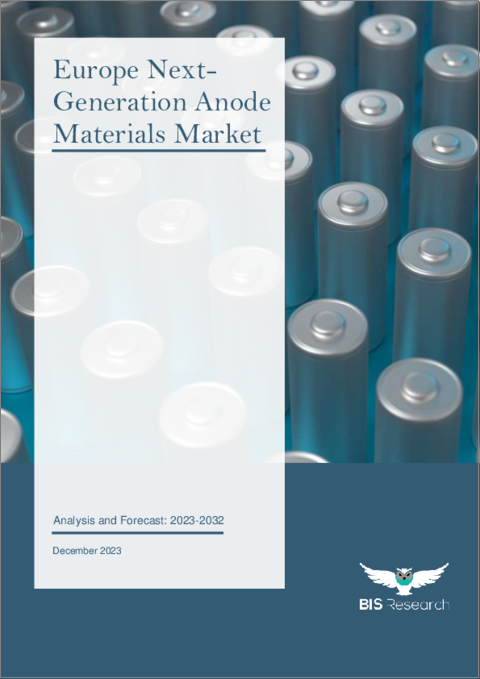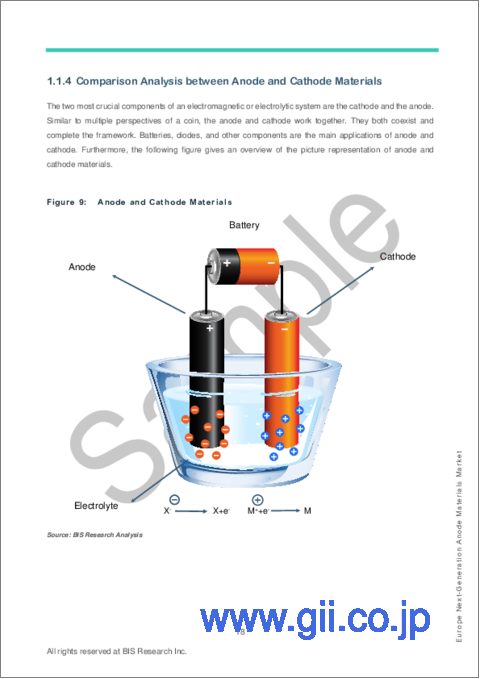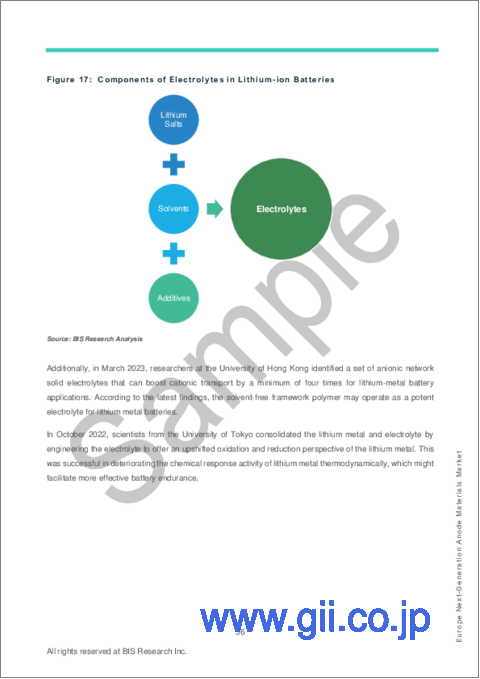|
|
市場調査レポート
商品コード
1399753
欧州の次世代アノード材料市場 - 分析と予測(2023年~2032年)Europe Next-Generation Anode Materials Market - Analysis and Forecast, 2023-2032 |
||||||
カスタマイズ可能
|
|||||||
| 欧州の次世代アノード材料市場 - 分析と予測(2023年~2032年) |
|
出版日: 2023年12月28日
発行: BIS Research
ページ情報: 英文 98 Pages
納期: 1~5営業日
|
- 全表示
- 概要
- 図表
- 目次
欧州の次世代アノード材料市場(英国を除く)の市場規模は、2022年に2億3,820万米ドルとなりました。
同市場は今後、21.63%のCAGRで成長し、2032年には16億3,180万米ドルに達すると予測されています。より高速な充電特性と出力密度を向上させた次世代アノード材料への需要の高まりが、欧州の次世代アノード材料市場の成長を後押しするとみられます。
| 主要市場統計 | |
|---|---|
| 予測期間 | 2023年~2032年 |
| 2023年評価 | 2億8,000万米ドル |
| 2032年予測 | 16億3,000万米ドル |
| CAGR | 21.63% |
次世代アノード材料の欧州市場は、参入企業の増加とともに急速に拡大しています。電池技術の飛躍的進歩、電気自動車やエネルギー貯蔵ソリューションの利用の増加が、この拡大を後押ししています。さらに、高度なエネルギー貯蔵技術への支出が増加していることも、次世代アノード材料セクターを前進させています。再生可能エネルギー源は、炭素への影響が少なく製造コストが安いため、世界中で人気を集めています。
次世代アノード材料が旧来の電池技術より優れている点は、その性能の高さです。その結果、これらの材料は、特に輸送、エネルギー貯蔵、電気・電子分野で高い需要があります。その結果、次世代アノード材料市場における既存参入企業と新興参入企業の競合は、予測期間を通じて過熱すると予測されます。
結論として、次世代アノード材料の欧州市場は、技術の進歩、電気自動車とエネルギー貯蔵ソリューションの採用増加、高度なエネルギー貯蔵技術への投資により、かなりの拡大が見られます。これらの材料は、従来の代替材料よりも効果が高いため、さまざまな産業で需要が増加しています。この市場は、既存参入企業と新規参入参入企業の間で競争が激化する可能性が高いとみられています。
当レポートでは、欧州の次世代アノード材料市場について調査し、市場の概要とともに、用途別、製品別、地域別の動向、および市場に参入する企業のプロファイルなどを提供しています。
目次
エグゼクティブサマリー
調査範囲
第1章 市場
- 業界の展望
- ビジネスダイナミクス
- スタートアップの情勢
- エコシステムにおける主要なスタートアップ企業
第2章 地域
- 欧州
- 市場
- 用途
- 製品
- 欧州(国別)
- 英国
- 市場
- 用途
- 製品
第3章 市場-競合ベンチマーキングと企業プロファイル
- 競合ベンチマーキング
- 競争力マトリックス
- 主要企業の製品マトリクス(タイプ別)
- 主要企業の市場シェア分析、2022年
- 企業プロファイル
- LeydnJar Technologies BV
- Nexeon Ltd.
第4章 調査手法
List of Figures
- Figure 1: Next-Generation Anode Materials Market, $Million, 2022, 2023, and 2032
- Figure 2: Next-Generation Anode Materials Market (by End User), $Million, 2022 and 2032
- Figure 3: Next-Generation Anode Materials Market (by Type), $Million, 2022 and 2032
- Figure 4: Next-Generation Anode Materials Market (by Region), $Million, 2022 and 2032
- Figure 5: Electric Vehicle Sales, Million Units, 2020, 2025, and 2030
- Figure 6: Production Data of Ferrosilicon and Silicon, Thousand Metric Tons, 2018-2022
- Figure 7: Recycling Process of Silicon into Anode Material for Lithium-Ion Batteries
- Figure 8: Supply Chain Analysis of the Next-Generation Anode Materials Market
- Figure 9: Anode and Cathode Materials
- Figure 10: Comparison Analysis between Anode and Cathode Materials
- Figure 11: Business Dynamics for Next-Generation Anode Materials Market
- Figure 12: Production and Reserves Data of Silicon, Thousand Metric Tons, 2021 and 2022
- Figure 13: Battery Storage Capabilities (by Country), 2020 and 2026
- Figure 14: Stability of Silicon Particles Varying with Diameter Size
- Figure 15: Clean Energy Investment in the Net Zero Pathway, $Trillion, 2016-2020, 2030, and 2050
- Figure 16: Advancements in Polymer Binders for Silicon based Anodes
- Figure 17: Components of Electrolytes in Lithium-ion Batteries
- Figure 18: Research Methodology
- Figure 19: Top-Down and Bottom-Up Approach
- Figure 20: Next-Generation Anode Materials Market: Influencing Factors
- Figure 21: Assumptions and Limitations
List of Tables
- Table 1: Major Key Investor of Solid-State Batteries
- Table 2: Stakeholders of the Next-Generation Anode Materials Market
- Table 3: List of Regulatory/Certification Bodies
- Table 4: List of Government Programs for the Next-Generation Anode Materials Market
- Table 5: List of Programs by Research Institutions and Universities
- Table 6: Key Investments by Companies
- Table 7: Comparison Table of Key Metrics
- Table 8: Key Product and Market Development
- Table 9: Key Mergers and Acquisitions, Partnerships, Collaborations, and Joint Ventures
- Table 10: Next-Generation Anode Materials Market (by Region), Kilo Tons, 2022-2032
- Table 11: Next-Generation Anode Materials Market (by Region), $Million, 2022-2032
- Table 12: Europe America Next-Generation Anode Materials Market (by End User), Tons, 2022-2032
- Table 13: Europe Next-Generation Anode Materials Market (by End User), $Million, 2022-2032
- Table 14: Europe Next-Generation Anode Materials Market (by Type), Tons, 2022-2032
- Table 15: Europe Next-Generation Anode Materials Market (by Type), $Million, 2022-2032
- Table 16: Germany Next-Generation Anode Materials Market (by End User), Tons, 2022-2032
- Table 17: Germany Next-Generation Anode Materials Market (by End User), $Million, 2022-2032
- Table 18: Germany Next-Generation Anode Materials Market (by Type), Tons, 2022-2032
- Table 19: Germany Next-Generation Anode Materials Market (by Type), $Million, 2022-2032
- Table 20: Spain Next-Generation Anode Materials Market (by End User), Tons, 2022-2032
- Table 21: Spain Next-Generation Anode Materials Market (by End User), $Million, 2022-2032
- Table 22: Spain Next-Generation Anode Materials Market (by Type), Tons, 2022-2032
- Table 23: Spain Next-Generation Anode Materials Market (by Type), $Million, 2022-2032
- Table 24: Poland Next-Generation Anode Materials Market (by End User), Tons, 2022-2032
- Table 25: Poland Next-Generation Anode Materials Market (by End User), $Million, 2022-2032
- Table 26: Poland Next-Generation Anode Materials Market (by Type), Tons, 2022-2032
- Table 27: Poland Next-Generation Anode Materials Market (by Type), $Million, 2022-2032
- Table 28: Hungary Next-Generation Anode Materials Market (by End User), Tons, 2022-2032
- Table 29: Hungary Next-Generation Anode Materials Market (by End User), $Million, 2022-2032
- Table 30: Hungary Next-Generation Anode Materials Market (by Type), Tons, 2022-2032
- Table 31: Hungary Next-Generation Anode Materials Market (by Type), $Million, 2022-2032
- Table 32: Rest-of-Europe Next-Generation Anode Materials Market (by End User), Tons, 2022-2032
- Table 33: Rest-of-Europe Next-Generation Anode Materials Market (by End User), $Million, 2022-2032
- Table 34: Rest-of-Europe Next-Generation Anode Materials Market (by Type), Tons, 2022-2032
- Table 35: Rest-of-Europe Next-Generation Anode Materials Market (by Type), $Million, 2022-2032
- Table 36: U.K. Next-Generation Anode Materials Market (by End User), Tons, 2022-2032
- Table 37: U.K. Next-Generation Anode Materials Market (by End User), $Million, 2022-2032
- Table 38: U.K. Next-Generation Anode Materials Market (by Type), Tons, 2022-2032
- Table 39: U.K. Next-Generation Anode Materials Market (by Type), $Million, 2022-2032
- Table 40: Product Matrix of Key Companies (by Type)
- Table 41: Market Shares of Key Companies, 2022
Introduction to Europe Next-Generation Anode Materials Market
The Europe next-generation anode materials market (excluding U.K.) was valued at $238.2 million in 2022, and it is expected to grow at a CAGR of 21.63% and reach $1,631.8 million by 2032. The growing demand for next-generation anode materials with faster charging properties and increased power density is likely to fuel growth in the Europe next-generation anode materials market.
Market introduction
| KEY MARKET STATISTICS | |
|---|---|
| Forecast Period | 2023 - 2032 |
| 2023 Evaluation | $0.28 Billion |
| 2032 Forecast | $1.63 Billion |
| CAGR | 21.63% |
The European market for next-generation anode materials is expanding rapidly as more companies enter the market. Battery technology breakthroughs, as well as the increasing usage of electric vehicles and energy storage solutions, are driving this increase. Furthermore, growing expenditures in sophisticated energy storage technologies are propelling the next-generation anode materials sector forward. Renewable energy sources are gaining popularity around the world due to their minimal carbon impact and inexpensive manufacturing costs.
One of the primary advantages of next-generation anode materials over old battery technologies is their better performance. As a result, these materials are in high demand, notably in the transportation, energy storage, and electrical and electronics sectors. As a result, competition in the next-generation anode materials market between established and emergent players is projected to heat up throughout the forecast period.
In conclusion, the European market for next-generation anode materials is seeing considerable expansion, owing to technological advancements, increased adoption of electric vehicles and energy storage solutions, and investments in advanced energy storage technologies. The enhanced effectiveness of these materials over traditional alternatives contributes to their increased demand in a variety of industries. This market is likely to become more competitive among established and new industry players.
Market Segmentation:
Segmentation 1: By End User
- Transportation
- Passenger Electric Vehicles
- Commercial Electric Vehicles
- Others
- Electrical and Electronics
- Energy Storage
- Others
Segmentation 2: By Type
- Silicon/Silicon Oxide Blend
- Lithium Titanium Oxide
- Silicon-Carbon Composite
- Silicon-Graphene Composite
- Lithium Metal
- Others
Segmentation 3: by Country
- Germany
- Spain
- Poland
- Hungary
- Rest-of-Europe
How can this report add value to an organization?
Product/Innovation Strategy: The product segment helps the reader to understand the different types involved in the Europe next-generation anode materials market. Moreover, the study provides the reader with a detailed understanding of the global next-generation anode materials market based on the end user (transportation, electrical and electronics, energy storage, and others). Next-generation anode materials market is gaining traction in end-user industries on the back of sustainability concerns and their higher efficiency properties. Next-generation anode materials are also being used for controlling green house gas (GHG) emissions. Moreover, partnerships and collaborations are expected to play a crucial role in strengthening market position over the coming years, with the companies focusing on bolstering their technological capabilities and gaining a dominant market share in the next-generation anode materials industry.
Growth/Marketing Strategy: The Europe next-generation anode materials market has been growing at a rapid pace. The market offers enormous opportunities for existing and emerging market players. Some of the strategies covered in this segment are mergers and acquisitions, product launches, partnerships and collaborations, business expansions, and investments. The strategies preferred by companies to maintain and strengthen their market position primarily include partnerships, agreements, and collaborations.
Competitive Strategy: The key players in the Europe next-generation anode materials market analyzed and profiled in the study include next-generation anode materials providers that develop, maintain, and market next-generation anode materials. Moreover, a detailed competitive benchmarking of the players operating in the Europe next-generation anode materials market has been done to help the reader understand the ways in which players stack against each other, presenting a clear market landscape. Additionally, comprehensive competitive strategies such as partnerships, agreements, and collaborations will aid the reader in understanding the untapped revenue pockets in the market.
Table of Contents
Executive Summary
Scope of the Study
1. Markets
- 1.1. Industry Outlook
- 1.1.1. Trends: Current and Future
- 1.1.1.1. Expanding Market of Next-Generation Anode Materials for Electric Vehicles
- 1.1.1.2. Focus on Silicon Recycling Promotes Applications in Lithium-Ion Batteries
- 1.1.1.3. Growing Demand for Solid-State Lithium-Metal Batteries in Various End-Use Applications
- 1.1.2. Supply Chain Analysis
- 1.1.3. Ecosystem of Next-Generation Anode Materials Market
- 1.1.3.1. Consortiums and Associations
- 1.1.3.2. Regulatory/Certification Bodies
- 1.1.3.3. Government Programs
- 1.1.3.4. Programs by Research Institutions and Universities
- 1.1.4. Comparison Analysis between Anode and Cathode Materials
- 1.1.5. Investment Scenario
- 1.1.1. Trends: Current and Future
- 1.2. Business Dynamics
- 1.2.1. Business Drivers
- 1.2.1.1. Increasing Need for Fast Charging and High-Density Batteries
- 1.2.1.2. Growing Demand of Silicon Material Due to Low Cost, Sustainable, and Abundant Nature
- 1.2.1.3. Increased Frequency of R&D Projects to Enhance Battery Composition
- 1.2.1.4. Increasing Investment in Advanced Energy Storage Technologies
- 1.2.2. Business Restraints
- 1.2.2.1. High Cost of Next-Generation Anode Materials
- 1.2.2.2. Lack of Large-Scale Production of High-Quality Graphene
- 1.2.2.3. Increased Volume and Degradation of Silicon Anodes
- 1.2.3. Business Strategies
- 1.2.3.1. Product and Market Development
- 1.2.4. Corporate Strategies
- 1.2.4.1. Mergers and Acquisitions, Partnerships, Collaborations, and Joint Ventures
- 1.2.5. Business Opportunities
- 1.2.5.1. Increasing Investment in Renewable Energy Sources
- 1.2.5.2. Growing Concern for the Environment and Carbon Neutrality Targets
- 1.2.5.3. Creating Resilient Binders for Assuring the Stability of Silicon Anodes
- 1.2.5.4. Designing New Electrolytes for Lithium Metal Batteries
- 1.2.1. Business Drivers
- 1.3. Start-Up Landscape
- 1.3.1. Key Start-Ups in the Ecosystem
2. Regions
- 2.1. Europe
- 2.1.1. Market
- 2.1.1.1. Key Manufacturers/Suppliers in Europe
- 2.1.1.2. Business Drivers
- 2.1.1.3. Business Challenges
- 2.1.2. Application
- 2.1.2.1. Europe Next-Generation Anode Materials Market (by End User), Volume and Value Data
- 2.1.3. Product
- 2.1.3.1. Europe Next-Generation Anode Materials Market (by Type), Volume and Value Data
- 2.1.4. Europe (by Country)
- 2.1.4.1. Germany
- 2.1.4.1.1. Market
- 2.1.4.1.1.1. Buyer Attributes
- 2.1.4.1.1.2. Key Manufacturers/Suppliers in Germany
- 2.1.4.1.1.3. Regulatory Landscape
- 2.1.4.1.1.4. Business Drivers
- 2.1.4.1.1.5. Business Challenges
- 2.1.4.1.2. Application
- 2.1.4.1.2.1. Germany Next-Generation Anode Materials Market (by End User), Volume and Value Data
- 2.1.4.1.3. Product
- 2.1.4.1.3.1. Germany Next-Generation Anode Materials Market (by Type), Volume and Value Data
- 2.1.4.1.1. Market
- 2.1.4.2. Spain
- 2.1.4.2.1. Market
- 2.1.4.2.1.1. Buyer Attributes
- 2.1.4.2.1.2. Key Manufacturers/Suppliers in Spain
- 2.1.4.2.1.3. Regulatory Landscape
- 2.1.4.2.1.4. Business Drivers
- 2.1.4.2.1.5. Business Challenges
- 2.1.4.2.2. Application
- 2.1.4.2.2.1. Spain Next-Generation Anode Materials Market (by End User), Volume and Value Data
- 2.1.4.2.3. Product
- 2.1.4.2.3.1. Spain Next-Generation Anode Materials Market (by Type), Volume and Value Data
- 2.1.4.2.1. Market
- 2.1.4.3. Poland
- 2.1.4.3.1. Market
- 2.1.4.3.1.1. Buyer Attributes
- 2.1.4.3.1.2. Key Manufacturers/Suppliers in Poland:
- 2.1.4.3.1.3. Regulatory Landscape
- 2.1.4.3.1.4. Business Drivers
- 2.1.4.3.1.5. Business Challenges
- 2.1.4.3.2. Application
- 2.1.4.3.2.1. Poland Next-Generation Anode Materials Market (by End User), Volume and Value Data
- 2.1.4.3.3. Product
- 2.1.4.3.3.1. Poland Next-Generation Anode Materials Market (by Type), Volume and Value Data
- 2.1.4.3.1. Market
- 2.1.4.4. Hungary
- 2.1.4.4.1. Market
- 2.1.4.4.1.1. Buyer Attributes
- 2.1.4.4.1.2. Key Manufacturers/Suppliers in Hungary:
- 2.1.4.4.1.3. Regulatory Landscape
- 2.1.4.4.1.4. Business Drivers
- 2.1.4.4.1.5. Business Challenges
- 2.1.4.4.2. Application
- 2.1.4.4.2.1. Hungary Next-Generation Anode Materials Market (by End User), Volume and Value Data
- 2.1.4.4.3. Product
- 2.1.4.4.3.1. Hungary Next-Generation Anode Materials Market (by Type), Volume and Value Data
- 2.1.4.4.1. Market
- 2.1.4.5. Rest-of-Europe (RoE)
- 2.1.4.5.1. Market
- 2.1.4.5.1.1. Buyer Attributes
- 2.1.4.5.1.2. Key Manufacturers/Suppliers in Rest-of-Europe:
- 2.1.4.5.1.3. Business Drivers
- 2.1.4.5.1.4. Business Challenges
- 2.1.4.5.2. Application
- 2.1.4.5.2.1. Rest-of-Europe Next-Generation Anode Materials Market (by End User), Volume and Value Data
- 2.1.4.5.3. Product
- 2.1.4.5.3.1. Rest-of-Europe Next-Generation Anode Materials Market (by Type), Volume and Value Data
- 2.1.4.5.1. Market
- 2.1.4.1. Germany
- 2.1.1. Market
- 2.2. U.K.
- 2.2.1. Market
- 2.2.1.1. Buyer Attributes
- 2.2.1.2. Key Manufacturers/Suppliers in the U.K.
- 2.2.1.3. Regulatory Landscape
- 2.2.1.4. Business Drivers
- 2.2.1.5. Business Challenges
- 2.2.2. Application
- 2.2.2.1. U.K. Next-Generation Anode Materials Market (by End User), Volume and Value Data
- 2.2.3. Product
- 2.2.3.1. U.K. Next-Generation Anode Materials Market (by Type), Volume and Value Data
- 2.2.1. Market
3. Markets - Competitive Benchmarking & Company Profiles
- 3.1. Competitive Benchmarking
- 3.1.1. Competitive Position Matrix
- 3.1.2. Product Matrix of Key Companies (by Type)
- 3.1.3. Market Share Analysis of Key Companies, 2022
- 3.2. Company Profiles
- 3.2.1. LeydnJar Technologies BV
- 3.2.1.1. Company Overview
- 3.2.1.1.1. Role of LeydnJar Technologies BV in the Next-Generation Anode Materials Market
- 3.2.1.1.2. Product Portfolio
- 3.2.1.2. Business Strategies
- 3.2.1.2.1. Product Development
- 3.2.1.2.2. Market Development
- 3.2.1.3. Corporate Strategies
- 3.2.1.3.1. Partnerships, Collaborations, and Joint Ventures
- 3.2.1.4. Analyst View
- 3.2.1.1. Company Overview
- 3.2.2. Nexeon Ltd.
- 3.2.2.1. Company Overview
- 3.2.2.1.1. Role of Nexeon Ltd. in the Next-Generation Anode Materials Market
- 3.2.2.1.2. Product Portfolio
- 3.2.2.2. Business Strategies
- 3.2.2.2.1. Market Development
- 3.2.2.3. Corporate Strategies
- 3.2.2.3.1. Partnerships, Collaborations, and Joint Ventures
- 3.2.2.4. Analyst View
- 3.2.2.1. Company Overview
- 3.2.1. LeydnJar Technologies BV
4. Research Methodology
- 4.1. Primary Data Sources
- 4.2. BIS Data Sources
- 4.3. Assumptions and Limitations





